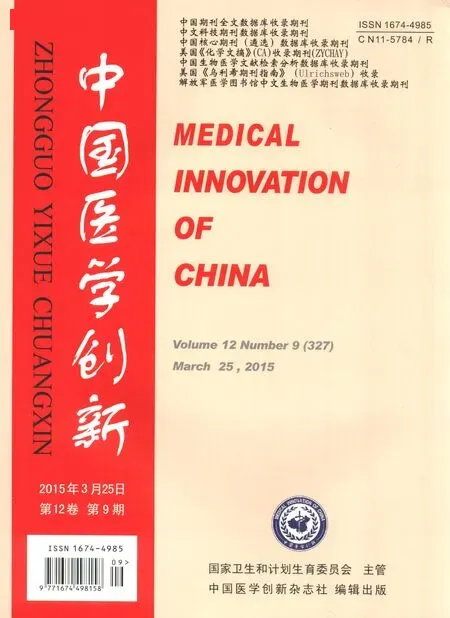三维肿瘤球聚体的构建及其研究进展*
2015-02-01李正钧梁高峰
李正钧梁高峰
三维肿瘤球聚体的构建及其研究进展*
李正钧①梁高峰①
三维体外细胞培养既能模拟体内细胞之间以及细胞外基质间信号转导的微环境,又可再现细胞培养的直观性及条件可控性。近年来三维体外细胞培养技术在生物医学研究中有着越来越广泛的应用,是药物毒性、肿瘤多耐药性、抗肿瘤药物高通量筛选及药物代谢等研究的有力工具。本文就三维肿瘤球聚体的构建及其最新的研究进展作简要综述。
三维细胞培养; 肿瘤球聚体; 生物材料; 药物筛选
细胞的生长环境和培养条件对细胞特定基因的表达及细胞的生物学行为能产生极大的影响,如细胞极性、结构、迁移、侵袭等[1-2]。目前,肿瘤的体外研究依然主要依靠肿瘤细胞的单层平面培养,然而传统单层培养的细胞无论是在形态、结构和功能等方面都与在体内自然生长的细胞有很大的差别,其无法真正反映体内呈三维状态生长的肿瘤。因此,在体外建立适合细胞和组织生长的生理微环境的三维细胞培养体系可方便地用于肿瘤侵袭和转移研究以及药物筛选的体外研究[3-5]。这种特定的类似组织样的三维微空间结构可以为体外生长的细胞提供类似体内生长环境的生物支撑或基质,建立细胞间及细胞与胞外基质间的相互联系。
由于在模拟细胞与细胞间、细胞与细胞外微环境相互作用方面的独特优势,近年来,三维细胞培养在肿瘤体外研究中获得广泛应用,成为肿瘤耐药、药物载体、药物毒理、肿瘤治疗、血管形成、信号转导、干细胞等方面研究不可或缺的有力工具[6-13]。特别是在抗肿瘤药物筛选方面,体外构建三维肿瘤球聚体与动物移植实体瘤模型相比,具有可重复性强、缩短研究时间、降低成本方面的优点,更不致引起动物伦理方面的争议。因而,在肿瘤体外研究中,体外构建三维肿瘤球聚体越来越受到研究者的青睐。
1 体外构建三维肿瘤球聚体主要方法
1.1 多孔支架培养法 体外二维培养肿瘤细胞很难聚集形成球状体,最初一些研究小组开发了支架培养肿瘤细胞成球,这种培养方法是利用体外肿瘤球状体可由生长在预制支架上的肿瘤细胞产生,细胞吸附和移居在缠绕的纤维上,随着细胞的分裂,它们填充支架内的间隙,这样会形成三维球状体[14-15]。不过支架的组成成分会对培养细胞的性能有很大的影响,目前,最常用的支架是胶原,此外,细胞外基质蛋白(ECM)也经常一起使用,同时,辅以必要的生长因子,这能增加细胞生长和含有其他调节因子的可能性。支架也可以用原代细胞和小片组织灌输。这种方法是较早、最常用、也是研究得最多的一类。
1.2 旋转培养法 在旋转培养出现以前,三维细胞培养都是静态培养,静态培养不利于营养物质和代谢废物的运输,妨碍肿瘤实体瘤的生长,为了解决这方面的不足,后来许多研究小组开发了动态培养方法如旋转烧瓶、滚筒试管、回转振荡器等[16-18]。其中美国NASA开发的旋转细胞培养体系是最有效的旋转培养装置,其工作原理是:凭借模仿微重力,保持细胞在动态流体中。培养器皿整体沿着它的水平轴旋转,以便上下颠覆混合细胞。借助于容器内被介质完全填满,能使流体冲击力和剪切力降到最小,通过半透膜能对培养瓶通气,而且半透膜能通过水动力排除气泡。这种培养系统的优点是:成功地实现了三维基质相互作用,但剪切力却较低。它提供了具备物质运输静态的三维球状体培养的环境。这种方法应用较为广泛,但构造较为复杂,实现起来比较繁琐,这一定程度上影响了其应用。
1.3 磁悬浮培养法 在磁悬浮培养提出以前,虽然蛋白质凝胶培养、转动生物反应器培养的多种三维培养方法。但这些方法操作起来有一定难度,而且生物可降解多空支架能使细胞增殖和细胞相互作用延迟的缺点,在实际中未能广泛应用。因此开发一个可操作性强的三维培养技术,仍是非常需要的。后来,有学者提出三维磁悬浮培养方法,这种方法的原理是:依靠磁铁的磁力和细胞的悬浮[19]。噬菌体、磁性四氧化三铁以及金纳米颗粒形成水凝胶,细胞摄取水凝胶,在培养器皿盖上面放一块磁铁,这样培养液处在磁铁的磁场当中,四氧化三铁被磁化,细胞将自动吸附聚集在一起形成球体。这种技术的优点是金噬菌体水凝胶生物兼容性好。所以,这种技术可替代生物可降解多空支架和蛋白质基质培养等技术。细胞培养的实验结果证实这种方法更能维持培养细胞的体内生理、形态等特性。这种方法具有较大的应用潜力。
1.4 纳米印迹培养板培养法 随着研究工作的深入,各种三维培养基质不断出现,如被琼脂、胶原包被的塑料基质,不过这些介质不能保持细胞在体内的增值、生存活性、均一等特性。而且这些介质对显微成像和光谱光度检测产生影响。有学者开发了一种用纳米压印技术形成的无机纳米级支架培养方法[14]。这种培养方法是利用纳米印迹技术把纳米级直角坐标网格式压印在合成树脂底部,其优点是:减少了细胞与基质的直接接触,避免了对细胞生化和生理特性的影响,也能维持细胞的增殖和存活率,便利了三维球体的形成,而且形成的肿瘤细胞球与体内形成的比较类似。也便于显微观察和光谱光度测量。这种方法简便易行、可操作性强,受到不少研究者的青睐,但所形成细胞球的体积有限。
1.5 实体瘤芯片 在实体瘤芯片开发以前,常规悬挂滴注培养被广泛地用于癌症生物医学研究中的三维肿瘤实体瘤构建。但这种用这种方法形成的肿瘤球体需要抽取,之后需转接入其他培养装置中进行灌注培养,为了解决这个问题,后来开发了许多微流体球芯片,但这些芯片有的是静态培养,有的虽然是灌注培养,但需要笨重的流体泵[20-22]。最近,Taeyoon小组开发了一种实体瘤芯片,这种芯片能进行自动介质滴注[23]。其工作原理是:培养液由滴注分配层滴入,待达到一定的平衡液面,培养废液从排水口排出。该方法设计巧妙、结构简单、经济实用,是目前研究的热点。
2 三维肿瘤球聚体的应用
三维细胞培养技术以其具有模拟体内微环境、较真实再现其功能的优势,现已在生物医学领域中广泛应用,近年来,分子生物学、生物力学、生物材料学、生物化学等诸多学科与组织工程学的不断融合促使体外细胞三维培养技术不断发展完善,培养条件逐渐接近体内环境,使目的细胞的结构和功能更接近体内状况。针对当前抗肿瘤药物筛选中,开大周期长、效率低、投入大等问题,根据具体情况,结合文中提到的这些方法可初步用于药物筛选的三维肿瘤模型及其芯片化装置。如以生物大分子(如蛋白质、多糖等)为主要原料的设计制备细胞培养三维支架方法;研究支架材料负载生物活性物质和支架材料的物理化学修饰对肿瘤细胞生长微环境和实体瘤形成的作用,并初步构建芯片器官综合体(或称芯片人体)中的芯片肿瘤组织单元,揭示肿瘤发生、转移的规律。发展体外自组织形成肿瘤细胞三维球聚体的新方法与新技术,研究肿瘤干细胞小生境的形成规律;发展体内实体肿瘤组织直接在体外培养的新方法与新技术,用于芯片恶性肿瘤模型的构建,研究其生物学特征,并可逐步用于抗肿瘤药物的大规模筛选与评价。
3 展望
体外肿瘤细胞三维培养模型已经从早期的支架培养、旋转培养、磁悬浮培养,发展到实体瘤芯片[24-26],已广泛应于抗肿瘤药物筛选研究中,其应用价值逐渐被研究者认同。可以预见通过这些方法构建的各种肿瘤模型将会与其他人体器官芯片(如:肝脏芯片、肺脏芯片、肾脏芯片等)整合在一起,为药物筛选及个体化诊疗提供依据[27-30]。同时,将会更有力的推动药物的研发。目前的迫切任务是规范这些研究所用的实验方法并探索实践新的技术方法,使其能被大多数研究机构接受。此外,还需进一步证实其可信性,以此获得管理部门的认可。此外,未来肿瘤细胞三维培养技术要求生物材料除了具有化学和工程学的功能以外,还需具有系统性的可控性,为生物医学研究提供具有良好功能的细胞、功能性三维组织、乃至功能性三维器官,满足大规模药物筛选的需求。
[1] Jacquemet G,Humphries M J,Caswell P T.Role of adhesion receptor trafficking in 3D cell migration[J]. Current opinion in cell biology,2013, 25(5):627-632.
[2] Kimlin L C,Casagrande G,Virador V M.In vitro threedimensional (3D) models in cancer research: an update[J].Molecular Carcinogenesis,2013,52(3):167-182.
[3] Perche F,Torchilin V P. Cancer cell spheroids as a model to evaluate chemotherapy protocols[J]. Cancer Biology & Therapy, 2012, 13(12):1205-1213.
[4] LaBarbera D V,Reid B G,Yoo B H. The multicellular tumor spheroid model for high-throughput cancer drug discovery[J]. Expert Opinion on Drug Discovery, 2012, 7(9):819-830.
[5] Karlsson H. Loss of cancer drug activity in colon cancer HCT-116 cells during spheroid formation in a new 3-D spheroid cell culture system[J]. Experimental Cell Research, 2012, 318(13):1577-1585.
[6] Jang K.Development of an osteoblast-based 3D continuous-perfusion microfluidic system for drug screening[J]. Analytical and Bioanalytical Chemistry, 2008, 390(3):825-832.
[7] Hartman O. Microfabricated electrospun collagen membranes for 3-D cancer models and drug screening applications[J].Biomacromolecules,2009,10(8):2019-2032.
[8] Goodman T T,Ng C P, Pun S H. 3-D Tissue culture systems for the evaluation and optimization of nanoparticle-based drug carriers[J]. Bioconjugate Chemistry, 2008, 19(10):1951-1959.
[9] Prestwich G D. 3-D culture in synthetic extracellular matrices:new tissue models for drug toxicology and cancer drug discovery[J]. Advances in Enzyme Regulation, 2007, 47(2):196-207.
[10] Biskup B. Diel Growth cycle of isolated leaf discs analyzed with a novel, high-throughput three-dimensional imaging method is identical to that of intact leaves[J]. Plant Physiology, 2009, 149(3):1452-1461.
[11] Seano G. Modeling human tumor angiogenesis in a three-dimensional culture system[J]. Blood, 2013, 121(21):E129-E137.
[12] Luca A C. Impact of the 3D microenvironment on phenotype, gene expression, and egfr inhibition of colorectal cancer cell lines[J].Plos One,2013, 8(3):201-203.
[13] Wang W. 3D spheroid culture system on micropatterned substrates for improved differentiation efficiency of multipotent mesenchymal stem cells[J]. Biomaterials, 2009, 30(14):2705-2715.
[14] Yoshii Y. The use of nanoimprinted scaffolds as 3D culture models to facilitate spontaneous tumor cell migration and well-regulated spheroid formation[J]. Biomaterials, 2011, 32(26):6052-6058.
[15] Breslin S, O'Driscoll L. Three-dimensional cell culture: the missing link in drug discovery[J]. Drug Discovery Today, 2013, 18(5-6):240-249.
[16] Achilli T M, Meyer J, Morgan J R. Advances in the formation, use and understanding of multi-cellular spheroids[J]. Expert Opinion on Biological Therapy, 2012, 12(10):1347-1360.
[17] Xu X. Recreating the tumor microenvironment in a bilayer, hyaluronic acid hydrogel construct for the growth of prostate cancer spheroids[J]. Biomaterials, 2012, 33(35):9049-9060.
[18] Goodwin T J.Reduced shear stress: a major component in the ability of mammalian tissues to form three-dimensional assemblies in simulated microgravity[J]. Journal of Cellular Biochemistry, 1993, 51(3):301-311.
[19] Souza G R. Three-dimensional tissue culture based on magnetic cell levitation[J]. Nature Nanotechnology, 2010, 5(4):291-296.
[20] Pampaloni F, Reynaud E G, Stelzer E H K. The third dimension bridges the gap between cell culture and live tissue[J]. Nature Reviews Molecular Cell Biology, 2007, 8(10):839-845.
[21] Lee P J,Hung P J,Lee L P. An artificial liver sinusoid with a microfluidic endothelial-like barrier for primary hepatocyte culture[J]. Biotechnology and Bioengineering, 2007, 97(5):1340-1346.
[22] Zervantonakis I K. Microfluidic devices for studying heterotypic cell-cell interactions and tissue specimen cultures under controlled microenvironments[J]. Biomicrofluidics, 2011, 5(1):25-26.
[23] Kim T, Doh I, Cho Y H. On-chip three-dimensional tumor spheroid formation and pump-less perfusion culture using gravity-driven cell aggregation and balanced droplet dispensing[J]. Biomicrofluidics,2012, 6(3):21-22.
[24] Huh D, Hamilton G A, Ingber D E. From 3D cell culture to organson-chips[J]. Trends in Cell Biology, 2011, 21(12):745-754.
[25] Kim H, Phung Y,Ho M. Changes in global gene expression associated with 3D structure of tumors: an ex vivo matrix-free mesothelioma spheroid model[J].Plos One, 2012, 7(6):78-79.
[26] Huang K Y. Size-dependent localization and penetration of ultrasmall gold nanoparticles in cancer cells, multicellular spheroids, and tumors in vivo[J]. Acs Nano, 2012, 6(5):4483-4493.
[27] Imura Y, Sato K, Yoshimura E. Micro total bioassay system for ingested substances: assessment of intestinal absorption, hepatic metabolism, and bioactivity[J]. Analytical Chemistry, 2010, 82(24):9983-9988.
[28] Ma L. Towards personalized medicine with a three-dimensional micro-scale perfusion-based two-chamber tissue model system[J]. Biomaterials, 2012, 33(17):4353-4361.
[29] Das T. Empirical chemosensitivity testing in a spheroid model of ovarian cancer using a microfluidics-based multiplex platform[J]. Biomicrofluidics, 2013, 7(1):23-24.
[30] Vinci M. Advances in establishment and analysis of three-dimensional tumor spheroid-based functional assays for target validation and drug evaluation[J]. Bmc Biology, 2012, 10(2):54-55.
Progress on Construction of Three-dimensional Tumor Spheroid
LI Zheng-jun,LIANG Gao-feng.// Medical Innovation of China,2015,12(09):147-149
Three-dimensional cell culture in vitro can not only simulate the microenvironment of intercellular signal transduction between cells and extracellular matrix, but also can reproduce the conditions in cell culture. In recent years, three-dimensional cell culture technology has increasingly widely used in biomedical research, which becomes a powerful tool for drug toxicity assay, tumor multi-drug resistance, high-throughput screening of anticancer drugs and drug metabolism. In this paper, we give a brief review of their latest research progress on construction of three-dimensional tumor spheroid in vitro.
Three-dimensional cell culture; Tumor spheroid; Biomaterial; Drug screening
10.3969/j.issn.1674-4985.2015.09.050
2014-08-24) (本文编辑:蔡元元)
国家自然基金资助项目(U1404824)
①河南曙光汇知康生物科技股份有限公司 河南 漯河 462332
李正钧
First-author’s address:He’nan Shuguang HZK Biological Technology Stock Co.,Ltd,Luohe 462332,China
